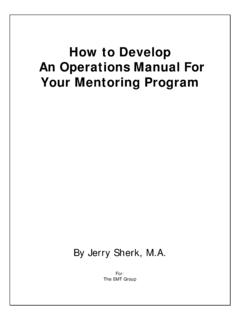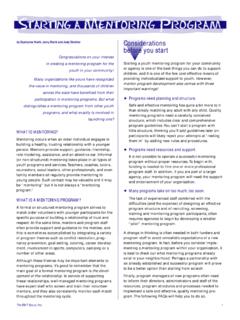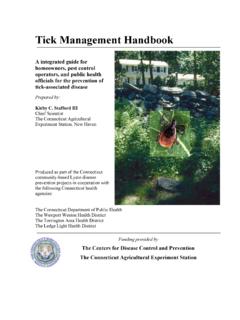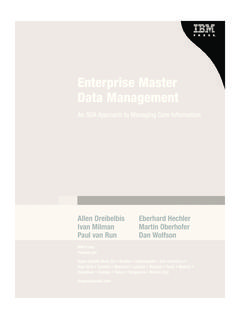Transcription of Mentee Prepare Text/Material - EMT: Evaluation, …
1 2002 Regional TrainingSymposiumsMENTORING ESSENTIALS:RISK MANAGEMENTFOR MENTORING PROGRAMSD ustianne North & Jerry SherkLos Angeles, San Diego, Monterey and SacramentoProduced by The EMT Group, Inc. for the California Department of Alcohol and Drug Programs2002 Regional TrainingSymposiums2002 Regional TrainingSymposiumsMENTORING ESSENTIALS:RISK MANAGEMENTFOR MENTORING PROGRAMSP roduced and Presented by:The EMT Group, 2002 Written and Presented by:DUSTIANNE NORTH, JERRY SHERK, TrainingSymposiumsWELCOMEW elcome to the Mentoring Essentials 2002 Regional TrainingSymposiums featuring Risk management for Mentoring Programs,a project of the Evaluation, management and Training (EMT) Group,Inc.
2 , funded through the California Department of Alcohol andDrug Programs. We are excited about this year s program and hopeyou find the day to be helpful and informative. The relaxed settingwill provide you with the opportunity to network with programpresenters and colleagues, and to explore how successfulstrategies can be incorporated into your own TODAY S TRAININGThe 2002 Regional Training Symposium will present asix-hour comprehensive approach to Risk management thatutilizes curricula based on the book More Than A Matter of Trust:Managing the risks of Mentoring, written by the Nonprofit RiskManagement Center in Washington, The workshop will coverthe six steps of risk management , and will help program managersand administrators to evaluate safety and liability issues in theirprogram, as well as to institute an ongoing risk management commitment to making a difference with our youth isappreciated.
3 Enjoy the day and thank you for joining MANAGEMENT2002 Regional TrainingSymposiumsTABLE OF CONTENTSM odule 1: What Is Risk management ?Module 2: Assessing RiskModule 3: Anticipating RisksModule 4: Strategizing To Reduce RiskModule 5: Preparing Participants For RiskModule 6: Troubleshooting Problems And Preventing CrisisModule 7: Minimizing Damage When Crisis OccursModule 8: Preventing Child Sexual Abuse in Mentoring ProgramsResourcesRISK MANAGEMENTPRESENTERSDUSTIANNE NORTH, North has been working in the field of youth mentoring since 1995, when she beganbuilding a mentor and volunteer program for the foster care in residence at the Florence CrittentonCenter in Los Angeles in 1995.
4 After creating the first mentoring program in Los Angeles Countyserving youth in foster care to receive official approval from LA County Department of Children andFamily Services, the LA Probation Department, and Community Care Licensing, Ms. North beganproviding training and technical assistance throughout the state for EMT. She specializes in assistingprograms that serve special needs populations such as court-involved youth. Ms. North has nowcompleted her at UCLA, and she continues to work toward her in Social Welfare (alsoat UCLA). She draws upon her experiences with mentoring, her clinical training as a social worker,and her administrative expertise in designing curricula and facilitating trainings.
5 This diverse scopeof knowledge allows her to work with direct practice issues such as communicating with youth, aswell as macro-level issues, such as designing mentor programs for foster SHERK, Sherk, MA, is President and founder of Mentor management Systems of Encinitas, a companythat provides technical assistance and training to both corporate and youth-based mentoringprograms. One of the leading consultants for EMT, Jerry has given workshops for hundreds ofprogram managers and mentors, while providing direct technical assistance to nearly 100 mentoringprograms. In this capacity he has helped approximately 50 mentoring agencies to develop theiroperational systems, as well as their participant training has also authored or co-authored a number of workbooks on youth mentoring including:Creating and Sustaining a Winning Match, Best Practices for Mentoring Programs, Preparing Menteesfor the Match, The Mentors' Guide to Workplace Mentoring, and Risk management for MentoringPrograms.
6 Jerry was recently hired by the California Social Worker Education Center (CalSWEC)at Cal Berkeley, to develop a program model for Social Workers to mentor newly hired ChildWelfare addition, Jerry is the past Executive Director and current Director of Special Projects for the MentoringCoalition of San Diego County, as well as Past President of the NFL Retired Players Association, SanDiego. From 1970-1981, Jerry was an All Pro defensive lineman for the Cleveland Browns, and hewas recently nominated for the NFL Pro Football Hall of Fame. Jerry lives in Encinitas, with his wife,two teenage children, and their Dachshund, MANAGEMENTSPECIAL THANKS & ACKNOWLEDGEMENTSFor their contributions to the success of our Regional Symposiums, The EMT Groupextends its gratitude to the following people and organizations: The California Department of Alcohol and Drug Programs for encouraging andsupporting the mentoring effort throughout California.
7 The presenters of the Regional Symposiums: Dustianne North and Jerry Sherk Shelly Boehm of EMT for database management and registration assistance for theRegional Symposiums. Art Farmer for the graphic design of the symposium materials. Jacquie Kramm for production management of the symposium materials. TC Printing for their print production of the symposium materials. Our guests who provide the insiration for these events. We hope that yourexpectations were exceeded and the day provided some useful information. Thankyou for your dedication to the mentoring movement and your participation their superb service and gracious hospitality, The EMT Group would like to thankthe staff members of the following businesses and organizations: Radisson Huntley Hotel Santa Monica The Catamaran Resort Hotel in San Diego The Doubletree Hotel in Monterey The Sierra Health Foundation in SacramentoRISK MANAGEMENTTODAY S AGENDARISK MANAGEMENT8:30 to 9:00 REGISTRATION AND CONTINENTAL BREAKFAST9:00 to 9:30 WELCOME AND INTRODUCTION9:30 to 9:45 MODULE 1: WHAT IS RISK management ?
8 9:45 to 10:30 MODULE 2: ASSESSING RISK10:30 to 10:45 BREAK10:45 to 11:05 MODULE 3: ANTICIPATING RISKS11:05 to 12:00 MODULE 4: STRATEGIZING TO REDUCE RISK12:00 to 1:00 LUNCH ON YOUR OWN1:00 to 1:45 MODULE 5: PREPARING PARTICIPANTS FOR RISK1:45 to 2:15 MODULE 6: TROUBLESHOOTING PROBLEMS ANDPREVENTING CRISIS2:15 to 2:30 BREAK2:30 to 3:00 MODULE 8: MINIMIZING DAMAGE WHENCRISIS OCCURS3:00 to 3:20 MODULE 9: PREVENTING CHILD SEXUAL ABUSEIN MENTORING PROGRAMS3:20 to 3:30 QUESTIONS, CLOSURE AND EVALUATIONRISK MANAGEMENT2002 Regional TrainingSymposiums2002 Regional TrainingSymposiumsWHAT ISRISK management ?MODULE 1 1 - 2 Risk management for Mentoring ProgramsEMTMODULE IWHAT IS RISK management ?
9 Introduction to Risk ManagementIn 1997, the President s Summit on Volunteerism convened in Philadelphiawith the charge of developing strategies to support America s troubledyouth. Chaired by Colin Powell, the Summit came up with a five-point-plan, and the first element was to provide each young person witha stable and caring adult. Since the Summit, the United States hasexperienced a fantastic expansion of youth mentoring working in the field know that youth mentoring programs typicallyhave to overcome many obstacles to first get up and running, and to keeptheir doors open. Those struggles usually begin with worries aboutfunding, and the next challenge is to find knowledgeable staff to developand run the program.
10 Individuals and organizations that made it past thoseoriginal hurdles can take pride in their successes. Not only have theysurvived, but through networking and the sharing of knowledge andresources, youth mentoring is getting major factor in building our industry has been that over the past severalyears, individuals and programs have contributed greatly to the vastknowledge base of mentoring. Slowly the evolution and awareness ofbest practices has evolved, and some people are even beginning to referto mentoring as a discipline in the much that same manner that socialwork and counseling are disciplines. Indeed, we now understand thatthere is a body of knowledge that must be mastered in order to design,implement, and sustain a youth mentoring to this point, with all the many formidable tasks facing mentoringprogram staff, and too few hours to get things done, risk management isone of the areas that seems to have been the most overlooked.







